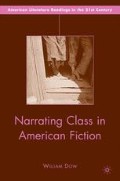Abstract
Rendering their physical environments foremost in terms of sensory impressions, Davis and Crane tried to come to terms with the social transformations that brought different class worlds (e.g., middle- and upper-class, middle- and lower-class) together. Accordingly, Life and Maggie handle class anxieties at a more properly aesthetic level, though with unsettling literary approaches to the nature of class difference and mobility. Like many other nineteenth-century writers, Davis and Crane increasingly saw the urban environments of America as a focus of the widening class rift between the poor and rich. Both writers created the identity of a middle-class reader in direct contrast to the commonly believed barbarism, perversion, and chaos embodied in the slum, working-class, and lower-class worlds.1 At the same time, wishing to bring into view what is hidden from the general view, what is unofficial, subversive, and even scandalous for their perceived readership, Davis and Crane generated stunningly new instances of cross-class perspectives.
Is this picture overdrawn? It all depends. For one who sees and thinks life in terms of shares and coupons, it is certainly overdrawn. But for one who sees and thinks life in terms of manhood and womanhood, it cannot be overdrawn.
The People of the Abyss (97–98)
Are they men?
The People of the Abyss (117)
Access this chapter
Tax calculation will be finalised at checkout
Purchases are for personal use only
Preview
Unable to display preview. Download preview PDF.
Notes
On the conditions of nineteenth-century American cities and the urban poor, see Giorgio Mariani, Spectacular Narratives: Representations of Class and War in Stephen Crane and the American 1890s ( New York: Peter Lang, 1992 ), 7–67;
June Howard, Form and History in American Literary Naturalism ( Chapel Hill: North Carolina UP, 1985 );
Paul Boyer, Urban Masses and Moral Order in America, 1820–1920 ( Cambridge, MA: Harvard UP, 1978 );
and Stuart M. Blumin, The Emergence of the Middle Class: Social Experiences in the American City, 1760–1900 ( Cambridge: Cambridge UP, 1989 ).
There is an astonishing consistency in the intimate entanglement of masculinity, emotion, and nationhood in the history of American culture, of which Abyss is an important representation. For studies of the relations and homologies between conceptions of race, sexuality, and nationality, see Boys Don’t Cry? Rethinking Narratives of Masculinity and Emotion in the U.S., ed. Milette Shamir and Jennifer Travis (New York: Columbia UP, 2002); George L. Mosse, The Image of Man: The Creation of Modern Masculinity (New York: Oxford UP, 1996); Sentimental Men: Masculinity and the Politics of Affect in American Culture, ed. Mary Chapman and Glenn Hendler ( Berkeley: Univ. of California Press, 1999 );
E. Anthony Rotundo, American Manhood; Michael S. Kimmel, Manhood in America: A Cultural History (New York: Free Press, 1996 ); and Across the Great Divide: Cultures of Manhood in the American West, ed. Matthew Basso, Dee Garceau, and Laura McCall ( New York: Routledge, 2001 ).
Jack London, The People of the Abyss, in Jack London: Novels and Social Writings, ed. Donald Pizer (New York: Library of America, 1982), 30. Further references to this work are given parenthetically.
For London’s creation of female characters and his position on the “New Woman,” see Andrew J. Furer, “Jack London’s New Woman”: 185–214 and Jeanne Campbell Reesman, “Jack London’s New Woman in a New World: Saxon Brown Roberts’ Journey into the Valley of the Moon,” American Literary Realism 24, 2 (Winter 1992): c–54.
See Peter Stallybrass and Allon White, The Politics and Poetics of Transgression (Ithaca, NY: Cornell UP, 1986) for their ideological distinctions between the bourgeois and proletarian body and their views on the pervasiveness of the mind/body split and its political importance to the bourgeois culture.
See Peter T. Okun, “John Barleycorn’s Body,” Arizona Quarterly 52, 2 (Summer 1996): 63–84.
Turn-of-the-century imperialism is discussed in Tony Smith, The Pattern of Imperialism (Cambridge: Cambridge UP, 1981); Robert Wiebe, The Search for Order, 1877–1920 ( New York: Hill and Wang, 1967 );
Mira Wilkins, The Emergence of Multinational Enterprise: American Business Abroad from the Colonial Era to 1914 ( Cambridge, MA: Harvard UP, 1974 );
and David Healy, U.S. Expansionism: The Imperialist Urge in the 1890s ( Madison: Univ. of Wisconsin Press, 1970 ).
For a complete listing of London’s journalism, see James Williams, “Jack London’s Works by Date of Composition,” in The World ofJack London. http://www.jacklondons.net Accessed November 26, 2007.
See Carolyn Johnston, Jack London: An American Radical? ( Westport, CT: Greenwood Press, 1984 ).
Copyright information
© 2009 William Dow
About this chapter
Cite this chapter
Dow, W. (2009). Body Tramping, Class, and Masculine Extremes: Jack London’s The People of the Abyss. In: Narrating Class in American Fiction. American Literature Readings in the 21st Century. Palgrave Macmillan, New York. https://doi.org/10.1057/9780230617964_4
Download citation
DOI: https://doi.org/10.1057/9780230617964_4
Publisher Name: Palgrave Macmillan, New York
Print ISBN: 978-1-349-37627-8
Online ISBN: 978-0-230-61796-4
eBook Packages: Palgrave Literature & Performing Arts CollectionLiterature, Cultural and Media Studies (R0)

